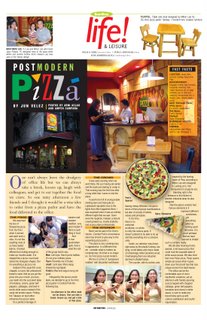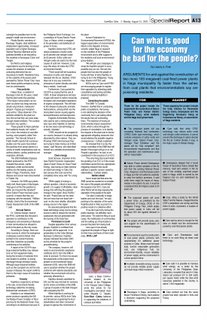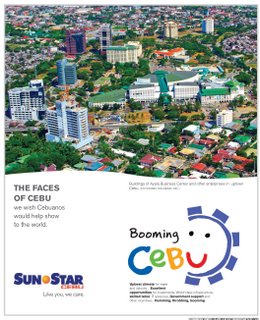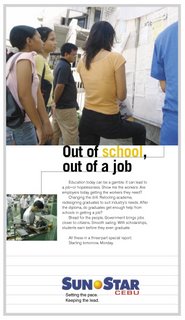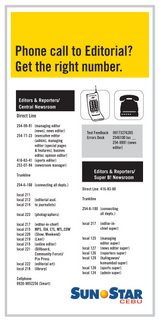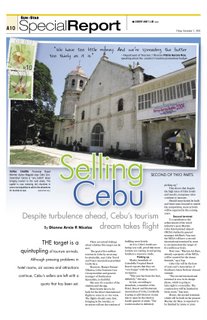Saturday, May 27, 2006
Thursday, May 25, 2006
Wednesday, May 24, 2006
Saturday, May 20, 2006
Wednesday, May 17, 2006
Digital Life
 The Mac has landed.
The Mac has landed.I'm referring to the Mac mini, the latest wonder from Apple computers, which formally had its marketing debut in Cebu last June 18. I anticipated it in this column, early this year, to give PCs a good competition after Apple’s Steve Jobs launched it (without the usual embarrassing glitch that often happen to Microsoft's Bill Gates during product launches).
Already, I know some friends who are buying it. DreamTech Enterprises, the authorized reseller and Service Center owned by Robert lee was offering a promotional package of either a free Mac keyboard or mouse with every purchase of the diminutive Mac. At a price of a PC, one gets to own a Mac.
But better than PCs, it has its ilife features, attuned to contemporary digital lifestyle, as well as PC applications like Microsoft Office and Internet Explorer. You can even run Windows as an application in the Mac.
Mac was the first to give people a more integrated and organized approach to modem digital living with the launching of Mac OS X that introduced iTunes, iDVD, iFotos. It sees the computer as the hub for digital equipments that have become indispensable to us, giving users a more systematic utilization of these gadgets. Now, it even gets better with the Tiger, the Mac’s latest operating system, with its real time search capability, among other new features.
It's a new world. We are in a new age. The byword today is digital integration and creative expression using the available technology. In a talk before some college students recently, I said this is the age of the individual. No other time in man's history has man been so free to express himself or herself. Where before, big organizations were needed to produce a film, music, publications, etc., now one can produce these in one's own garage or backyard. Thus, allowing for a freer and more creative and daring self-expression.
As I write this, I’m listening to Alicia Keys, one of the featured artists in a music CD from McDonald’s. Yes, the fast-food chain. They have produced a collection of hit songs from both foreign male and female artists. Here in Cebu they have launched a talent search for the best RnB singer dubbed, 'The Next Best Thing'. One just have to submit a recording to McDonald’s of one's RnB song and have a chance to be a music star (the winner being assured of a recording contract with Vicor.)
Everybody is living the digital lifestyle. And even big old corporations are reengineering. Individuals can make the difference in an organization provided it has a mechanism for allowing new ideas to set in. McDonald's latest marketing strategy, like that of Apple is acknowledging the new reality.
We're seeing the passing of an old world giving way to a new one. A generation of pioneering spirits in the I.T. industry are now seeing and welcoming the entry of a whole new generation born and bred on a digital world.
Just recently I was going over my son Joshua's books and came across Headstart, a computer literacy work text for Grade School. I browsed the book and was amused that the basic computer course I was taught in college for a semester, a few years ago, are now taught to my son, and he's still in Grade Two. Hopefully, he will be learning more with the real McCoy – the Mac that launched the digital revolution some twenty years ago.
Tuesday, May 16, 2006
Design rationale for sunstar
Working in a SunStar publication is like standing on the seashore where shifting sands beneath our feet force us to keep our balance. Nothing stays the same year after year. There are always new ways of producing the paper using the latest prepress hardware and applications. As technology keeps changing and developing, the paper’s look also changes, utilizing new design approaches and techniques that were not possible before.
But now is not the time to sound "techie" or futuristic. It’s time for remembering and this sort of makes me feel old. Belonging to a second generation of Sun.Star employees who have been in the company for the past five to ten years, I find this nostalgic trip like taking a sudden vacation.
A look at old issues of SunStar for the past two decades would show that it has gone through countless changes since it first saw print. Ironically, it is the paper’s maiden design that was most significant.
I take my hat off to the paper’s editor Atty. Pachico Seares. The maiden design of SunStar was remarkable. It was a first, and by community journalism standards, years ahead of the competition and probably of any community paper in the country at that time.
I was in high school when SunStar’s first issue came out. I remember there was a big fuss in our neighborhood in Minglanilla. The canto estambays, the resident sarisari store political observers and commentators were one in admiring the new paper, and talking about this guy Seares who bolted The Freeman to start a newspaper that promises to be different. Indeed, in its professional treatment of stories, sensible commentaries, sensational photojournalism and clean modern layout, the paper really stood out.
The maiden design was modern in the academic sense of the word. The choice of fonts was minimalist. The serif type Times Roman was predominantly used in the news pages. The sans serif type Helvetica or its variation gave the Life and Leisure pages a more relax look in contrast to the serious classic serifs of the news pages. The sports section also looked light with a sans serif type for its headlines.
The design was successful in simplifying to its most basic form the various elements that make up the paper. Unlike its contemporaries and predecessors, SunStar’s design had a central idea, a common thread that tied the different elements together.
The design’s only flaw was that it looked like a broadsheet, betraying the reality of its tabloid size. This is apparent in the miniaturization of the paper’s photographs, headlines, artworks, graphics, etc. (But it may had also been dictated by space constraints as the young paper tried to survive during its early years of operation.) There was also too much detail in the SunStar logo symbol found in the masthead. That probably explains the change years later.
The printing was noteworthy. The use of sheet fed offset printing machines and electronic typewriters spelled the difference. The lines, types, fills and images were clean. Halftones and solid blacks were used to maximum advantage. The paper’s design pushed the monochromatic characteristic of the paper beyond the functional and into the aesthetic.
Advertising’s exploitation of the new print medium was also remarkable. Ads made full use of duotone. The paper’s not being in full color was never a handicap for good designs. Red made wonders when paired with black. There were the full-page Penshoppe advertisements that made use of full-bleed black and white photographs. In a way, SunStar helped the growth of local advertising agencies. It created a demand for ad agency-designed advertisements.
Subsequent redesign saw the paper sporting an all black look in the front page. This was in 1988. It was the first major overhaul of the paper’s design since 1982. Trends in newspaper design, the use of web offset machines for printing and the new desktop publishing technology (with the introduction of the computer), ushered in a new era of newspaper production for Sun.Star. While work was faster, production quality however, wasn’t as good as the shift to non-postscript laser printouts and web offset printing resulted in lower resolution and increased dot gain. It would take a while before the paper’s production would use to full advantage the new technology.
After 13 years SunStar finally shifted to full color printing in 1995. For the first time it had a full color masthead. From duotone (1982) to monochromatic (1988), it finally went full color. But not quite, the 1995 redesign was a transition stage for full color photography and printing. Colored pages this time, carried both CMYK and grayscale images. The 1995 redesign also signaled the shift from a modern, monotonous pattern to an eclectic and playful design.
In 1997, Cebu’s print media landscape was radically changed with the entry of new players in the newspaper business. With this development and the shift to electronic prepress production, SunStar engaged in a major facelift. Further advancement in technology like the use of an imagesetter, and a new web offset machine allowed for major design and publishing innovations never possible before.
With the active involvement of its president, Atty. Jesus Garcia, Jr. and editor-in-chief Pachico Seares together with the publication’s newly formed art department, SunStar underwent a major design overhaul. A product of a two-month study, the design changed the paper’s look overnight. Unlike the previous redesigns, this one didn’t come in installments. It was the first time the paper was redesigned from cover to cover including entire sections. It eventually won for SunStar the Konrad Adenauer 1997 Community Press Award for the Best in Newspaper Design.
For years, SunStar’s design was confined within this premise: tabloid in size but broadsheet in look and content. Even the one that won for SunStar Best in Newspaper Design would be perfect if SunStar goes broadsheet. Realizing the inherent contradictions of looking like the broadsheets, the Art Department in 2000 proposed to the publisher and editor a new design principle that became the basis for SunStar’s present look, three years after the successful 1997 redesign.
In the same manner that modernist painters abandoned realism and celebrated the two dimensionality of the canvass, we acknowledged the limitations of our being a tabloid-sized paper. We accepted and transcended it. The paper’s design is primarily a function of its form or size.
A challenge to the graphic designers was how to maintain the paper’s seriousness and journalistic integrity while employing a more appropriate design. It was clear to everyone, simply because the paper’s size is tabloid (11x17), doesn’t mean it has to be a sensational, rumor mongering, making-a-mountain-out-of–a-molehill type of newspaper.
What we wanted was to overcome the paper’s smallness. We wanted the readers to forget it is such a small paper they’re holding. While mimicking the broadsheets make the paper look smaller, enlarging everything in it, minimizing the number of stories and expanding horizontally - that is, adding more pages - give the paper a semblance of hugeness.
The past three years saw us giving flesh to this design concept. And with the publisher and editor’s support, we have been successful in giving the paper a more contemporary and "politically correct" look. More importantly, we succeeded in preserving the paper’s respectability while packaging it as a tabloid-sized newspaper that is never tabloidish meaning, sensational, hyperbolic, exaggerating.
The changes had not been easy. Every new idea necessitated a change in thinking and ways of doing things. The newspaper business just like almost every facet of human activity had been radically transformed by the IT revolution. The company, and the art department in particular, had to downsize as technology made possible the employment of a leaner, multi-tasking organization helped further by an automated workflow.
Today, editors lay out their own news sections and pages based on a template designed by SunStar’s artists. Feature pages however, remain with artists as these require page designing. Editors now have a more direct hand in determining the paper’s final look, instead of merely sketching dummies that only double the time producing the paper.
For us artists, this is liberating for it means more time for creative activity having been freed from the routinely production nature of our work. What awaits us are a myriad of possibilities when art and technology meet. The computer is but another tool and medium that could unleash one’s reservoir of creativity.
Oftentimes, we wonder what’s the shape of things to come. As long as we welcome change like a surfer riding the waves, the future need not be a source of uneasiness or insecurity. I guess, we just have to get used to the feeling of not standing on solid ground like being on the seashore where shifting sands beneath our feet force us to keep our balance, always.
But now is not the time to sound "techie" or futuristic. It’s time for remembering and this sort of makes me feel old. Belonging to a second generation of Sun.Star employees who have been in the company for the past five to ten years, I find this nostalgic trip like taking a sudden vacation.
A look at old issues of SunStar for the past two decades would show that it has gone through countless changes since it first saw print. Ironically, it is the paper’s maiden design that was most significant.
I take my hat off to the paper’s editor Atty. Pachico Seares. The maiden design of SunStar was remarkable. It was a first, and by community journalism standards, years ahead of the competition and probably of any community paper in the country at that time.
I was in high school when SunStar’s first issue came out. I remember there was a big fuss in our neighborhood in Minglanilla. The canto estambays, the resident sarisari store political observers and commentators were one in admiring the new paper, and talking about this guy Seares who bolted The Freeman to start a newspaper that promises to be different. Indeed, in its professional treatment of stories, sensible commentaries, sensational photojournalism and clean modern layout, the paper really stood out.
The maiden design was modern in the academic sense of the word. The choice of fonts was minimalist. The serif type Times Roman was predominantly used in the news pages. The sans serif type Helvetica or its variation gave the Life and Leisure pages a more relax look in contrast to the serious classic serifs of the news pages. The sports section also looked light with a sans serif type for its headlines.
The design was successful in simplifying to its most basic form the various elements that make up the paper. Unlike its contemporaries and predecessors, SunStar’s design had a central idea, a common thread that tied the different elements together.
The design’s only flaw was that it looked like a broadsheet, betraying the reality of its tabloid size. This is apparent in the miniaturization of the paper’s photographs, headlines, artworks, graphics, etc. (But it may had also been dictated by space constraints as the young paper tried to survive during its early years of operation.) There was also too much detail in the SunStar logo symbol found in the masthead. That probably explains the change years later.
The printing was noteworthy. The use of sheet fed offset printing machines and electronic typewriters spelled the difference. The lines, types, fills and images were clean. Halftones and solid blacks were used to maximum advantage. The paper’s design pushed the monochromatic characteristic of the paper beyond the functional and into the aesthetic.
Advertising’s exploitation of the new print medium was also remarkable. Ads made full use of duotone. The paper’s not being in full color was never a handicap for good designs. Red made wonders when paired with black. There were the full-page Penshoppe advertisements that made use of full-bleed black and white photographs. In a way, SunStar helped the growth of local advertising agencies. It created a demand for ad agency-designed advertisements.
Subsequent redesign saw the paper sporting an all black look in the front page. This was in 1988. It was the first major overhaul of the paper’s design since 1982. Trends in newspaper design, the use of web offset machines for printing and the new desktop publishing technology (with the introduction of the computer), ushered in a new era of newspaper production for Sun.Star. While work was faster, production quality however, wasn’t as good as the shift to non-postscript laser printouts and web offset printing resulted in lower resolution and increased dot gain. It would take a while before the paper’s production would use to full advantage the new technology.
After 13 years SunStar finally shifted to full color printing in 1995. For the first time it had a full color masthead. From duotone (1982) to monochromatic (1988), it finally went full color. But not quite, the 1995 redesign was a transition stage for full color photography and printing. Colored pages this time, carried both CMYK and grayscale images. The 1995 redesign also signaled the shift from a modern, monotonous pattern to an eclectic and playful design.
In 1997, Cebu’s print media landscape was radically changed with the entry of new players in the newspaper business. With this development and the shift to electronic prepress production, SunStar engaged in a major facelift. Further advancement in technology like the use of an imagesetter, and a new web offset machine allowed for major design and publishing innovations never possible before.
With the active involvement of its president, Atty. Jesus Garcia, Jr. and editor-in-chief Pachico Seares together with the publication’s newly formed art department, SunStar underwent a major design overhaul. A product of a two-month study, the design changed the paper’s look overnight. Unlike the previous redesigns, this one didn’t come in installments. It was the first time the paper was redesigned from cover to cover including entire sections. It eventually won for SunStar the Konrad Adenauer 1997 Community Press Award for the Best in Newspaper Design.
For years, SunStar’s design was confined within this premise: tabloid in size but broadsheet in look and content. Even the one that won for SunStar Best in Newspaper Design would be perfect if SunStar goes broadsheet. Realizing the inherent contradictions of looking like the broadsheets, the Art Department in 2000 proposed to the publisher and editor a new design principle that became the basis for SunStar’s present look, three years after the successful 1997 redesign.
In the same manner that modernist painters abandoned realism and celebrated the two dimensionality of the canvass, we acknowledged the limitations of our being a tabloid-sized paper. We accepted and transcended it. The paper’s design is primarily a function of its form or size.
A challenge to the graphic designers was how to maintain the paper’s seriousness and journalistic integrity while employing a more appropriate design. It was clear to everyone, simply because the paper’s size is tabloid (11x17), doesn’t mean it has to be a sensational, rumor mongering, making-a-mountain-out-of–a-molehill type of newspaper.
What we wanted was to overcome the paper’s smallness. We wanted the readers to forget it is such a small paper they’re holding. While mimicking the broadsheets make the paper look smaller, enlarging everything in it, minimizing the number of stories and expanding horizontally - that is, adding more pages - give the paper a semblance of hugeness.
The past three years saw us giving flesh to this design concept. And with the publisher and editor’s support, we have been successful in giving the paper a more contemporary and "politically correct" look. More importantly, we succeeded in preserving the paper’s respectability while packaging it as a tabloid-sized newspaper that is never tabloidish meaning, sensational, hyperbolic, exaggerating.
The changes had not been easy. Every new idea necessitated a change in thinking and ways of doing things. The newspaper business just like almost every facet of human activity had been radically transformed by the IT revolution. The company, and the art department in particular, had to downsize as technology made possible the employment of a leaner, multi-tasking organization helped further by an automated workflow.
Today, editors lay out their own news sections and pages based on a template designed by SunStar’s artists. Feature pages however, remain with artists as these require page designing. Editors now have a more direct hand in determining the paper’s final look, instead of merely sketching dummies that only double the time producing the paper.
For us artists, this is liberating for it means more time for creative activity having been freed from the routinely production nature of our work. What awaits us are a myriad of possibilities when art and technology meet. The computer is but another tool and medium that could unleash one’s reservoir of creativity.
Oftentimes, we wonder what’s the shape of things to come. As long as we welcome change like a surfer riding the waves, the future need not be a source of uneasiness or insecurity. I guess, we just have to get used to the feeling of not standing on solid ground like being on the seashore where shifting sands beneath our feet force us to keep our balance, always.
Sunday, May 14, 2006
global look?
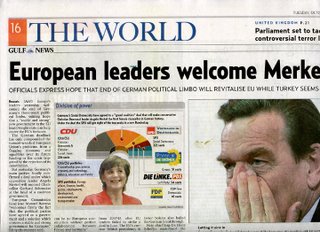
When I left the country a few months ago, I found out newspapers in other parts of the globe look very much like Sun.Star. Take Gulf News in Dubai, United Arab Emirates for instance. It has more or less the same look for section heads with SunStar. Same with its latest competitor, Emirates Today.
I was blabbering to my friends Franzty and Ador the first time I saw it. Another friend who also saw the newspaper made the same observation and commented, “Mura man ni og Sun.Star oi.”
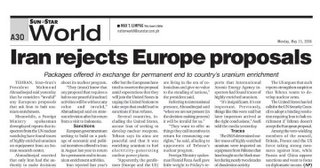 As a backgrounder, Gulf News is designed by no less than Mario Garcia, so called icon of newspaper design. He did the redesigns for the Wall Street Journal. (I was in the old domestic airport in Manila waiting for my Cebu Pacific flight years ago when I saw it and was really amazed how he was able to preserve the paper’s traditional look while at the same time giving it a 90s touch.)
As a backgrounder, Gulf News is designed by no less than Mario Garcia, so called icon of newspaper design. He did the redesigns for the Wall Street Journal. (I was in the old domestic airport in Manila waiting for my Cebu Pacific flight years ago when I saw it and was really amazed how he was able to preserve the paper’s traditional look while at the same time giving it a 90s touch.)I liked Garcia’s pre-compact newspaper designs. He now advocates compact newspaper as the wave of the future - something that a local newspaper followed. It recently had a redesign that also saw the newspaper resized.
Garcia made his point clear with the redesign of the San Francisco Examiner. I downloaded the pdf file of his redesign rationale years ago, impressed with his bold experiment.
I’m amazed at the influence he has on entire news organizations that he can tell everyone from the owners to the editor that not only the paper is going to change its look but also its treatment of stories. From a broadsheet, he transformed the Examiner to a compact size.
In a few years (although circulation surged for a while at the start) the Examiner lost money and was eventually sold. Last time I checked it is still struggling under new owners.
The similarity with the Garcia-designed newspaper is not really unexpected. Sun.Star is not designed as a broadsheet but as a tabloid-sized newspaper, while Garcia’s Gulf News design is influenced by his advocacy of compact sizes. Unlike his other works in broadsheet, his design for Gulf News is far from traditional.
Another Dubai newspaper looks similar to SunStar and more rightly so since it is of similar size. Emirates Today is guided by the same principle that govern Sun.Star’s design. Intrinsically, the two are anchored on the same philosophical basis – that size determines a paper’s form.
Almost everyone I’ve talked to regarding the newspaper’s design bring with them broadsheet layout ideas that just don’t ring true with the tabloid-sized SunStar. One has to stop looking at Sun.Star with broadsheet colored eyes – something that another local daily in Cebu, recently acquired by a national newspaper, learned the hard way. It had to make the mistake of making the local paper a clone of its national partner before realizing it just can’t work.
I’m not actually comfortable explaining myself here or critiquing other local dailies. Last time I did that, explaining Sun.Star’s design as being tabloid in size but never tabloidish in content, a competitor changed its editorial style. Maybe I’m assuming but hey, they had such ubiquitous timing.
